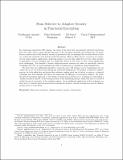| dc.contributor.author | Ananth, Prabhanjan | |
| dc.contributor.author | Brakerski, Zvika | |
| dc.contributor.author | Segev, Gil | |
| dc.contributor.author | Vaikuntanathan, Vinod | |
| dc.date.accessioned | 2021-11-08T20:55:17Z | |
| dc.date.available | 2021-11-08T20:55:17Z | |
| dc.date.issued | 2015 | |
| dc.identifier.issn | 0302-9743 | |
| dc.identifier.issn | 1611-3349 | |
| dc.identifier.uri | https://hdl.handle.net/1721.1/137827 | |
| dc.description.abstract | © International Association for Cryptologic Research 2015. In a functional encryption (FE) scheme, the owner of the secret key can generate restricted decryption keys that allow users to learn specific functions of the encrypted messages and nothing else. In many known constructions of FE schemes, security is guaranteed only for messages that are fixed ahead of time (i.e., before the adversary even interacts with the system). This so-called selective security is too restrictive for many realistic applications. Achieving adaptive security (also called full security), where security is guaranteed even for messages that are adaptively chosen at any point in time, seems significantly more challenging. The handful of known adaptively-secure schemes are based on specifically tailored techniques that rely on strong assumptions (such as obfuscation or multilinear maps assumptions) can be transformed into an adaptively-secure one without introducing any additional assumptions. We present a black-box transformation, for both public-key and private-key schemes, making novel use of hybrid encryption, a classical technique that was originally introduced for improving the efficiency of encryption schemes. We adapt the hybrid encryption approach to the setting of functional encryption via a technique for embedding a “hidden execution thread” in the decryption keys of the underlying scheme, which will only be activated within the proof of security of the resulting scheme. As an additional application of this technique, we show how to construct functional encryption schemes for arbitrary circuits starting from ones for shallow circuits (NC1 or even TC0). | en_US |
| dc.language.iso | en | |
| dc.publisher | Springer Nature | en_US |
| dc.relation.isversionof | 10.1007/978-3-662-48000-7_32 | en_US |
| dc.rights | Creative Commons Attribution-Noncommercial-Share Alike | en_US |
| dc.rights.uri | http://creativecommons.org/licenses/by-nc-sa/4.0/ | en_US |
| dc.source | Other repository | en_US |
| dc.title | From Selective to Adaptive Security in Functional Encryption | en_US |
| dc.type | Article | en_US |
| dc.identifier.citation | Ananth, Prabhanjan, Brakerski, Zvika, Segev, Gil and Vaikuntanathan, Vinod. 2015. "From Selective to Adaptive Security in Functional Encryption." | |
| dc.contributor.department | Massachusetts Institute of Technology. Department of Electrical Engineering and Computer Science | |
| dc.contributor.department | Massachusetts Institute of Technology. Computer Science and Artificial Intelligence Laboratory | |
| dc.eprint.version | Author's final manuscript | en_US |
| dc.type.uri | http://purl.org/eprint/type/ConferencePaper | en_US |
| eprint.status | http://purl.org/eprint/status/NonPeerReviewed | en_US |
| dc.date.updated | 2019-07-09T16:21:55Z | |
| dspace.date.submission | 2019-07-09T16:21:56Z | |
| mit.metadata.status | Authority Work and Publication Information Needed | en_US |
